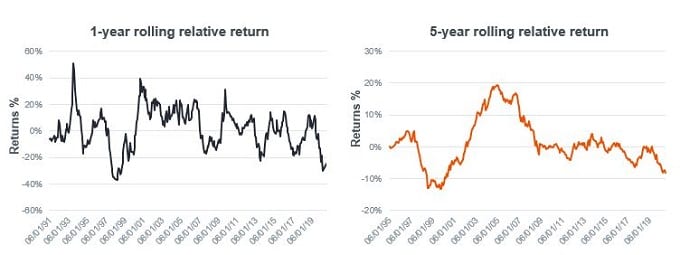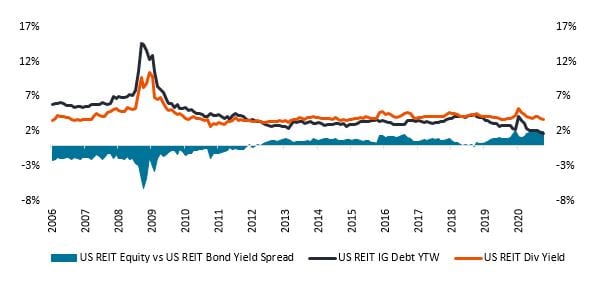Subscribe
Sign up for timely perspectives delivered to your inbox.
Real estate shares have been out of favour in recent years, and there are indications that listed property is currently undervalued. Portfolio managers Guy Barnard, Tim Gibson and Greg Kuhl assess the indicators and explore the associated risks and opportunities.

In a recent panel debate we were asked to discuss if we had seen any signs of valuation bubbles; our response in relation to the real estate market, was a somewhat flippant “chance would be a fine thing”. The other panel participants, investors in technology, healthcare and sustainable equity strategies all agreed that there are segments in their asset classes in which caution was certainly warranted – hydrogen technologies anyone?
As illustrated in figure 1, this level of relative underperformance is rare and was last witnessed in the build up to the dot-com crash. Property stocks subsequently generated returns of 16% p.a. over the five years from 2000 to 2005; in contrast global equities’ returns were flat.2 While we would certainly not claim that ‘all else is equal’, it certainly bears some consideration.

While much attention recently has fallen on a shift in expectations toward rising inflation and a steepening bond yield curve, the US 10-year Treasury yield (at the time of writing), is around 0.7% lower than it was a year ago. This makes the relative difference in performance between wider equity markets and the real estate sector seem somewhat outsized.
One observation worth highlighting in the current market is the divergence in valuations between the REIT equity and REIT debt markets (US data shown in figure 2). In the debt market, REIT corporate credit and commercial mortgage-backed securities (CMBS) yield spreads over treasuries have returned to pre-pandemic levels, and are also in-line with their longer-term history (figure 3). This suggests that debt investors view the risk profile of the asset class as having fully recovered from the pandemic. However, in the equity market, many valuation metrics including REITs’ dividend yield spread versus the yield on their own debt instruments are at or close to all-time wides.

Given that debt financing is a key part of most REITs’ capital structure, it is also hugely beneficial that the yields on REIT investment grade (IG) corporate credit and investment grade CMBS are at around 20+ year lows (both 1.7% at the end of 2020) – see figure 3. This presents REIT management teams with a significant opportunity to generate interest savings by refinancing existing debt, or to fund new acquisitions with very cheap long-term debt. Plentiful debt at low interest rates could also present private buyers with opportunities to generate outsized returns via merger and acquisition activity involving listed REITs or private real estate.

In conclusion, against a backdrop where return expectations across many other asset classes have declined, we believe real estate income is beginning to stand out as being attractive in both the direct and listed real estate markets. Moreover, in our view, the recent strength in real estate debt markets could be a precursor to future strength in listed real estate.